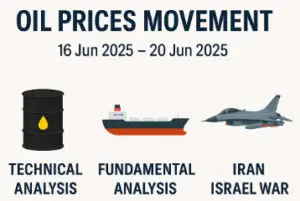Weekly Forex Performance Analysis (16–20 June): Insights, Trends & Impacts
Price Movement for the Week: June 16–20
The Forex market experienced a week of mixed sentiment from June 16 to June 20, with significant shifts in major currency pairs influenced by both macroeconomic updates and rising geopolitical tensions—especially the ongoing Iran Israel war. The price movement across the board reflected heightened investor sensitivity to global risk, central bank policy hints, and regional conflicts.
The USD/JPY pair displayed strong upward price movement, climbing from the 157.30 range to flirt with 159.75 by Thursday. This continued rally was largely fueled by stronger-than-expected U.S. data and a cautious global sentiment. Traders preferred the U.S. dollar as a safe-haven, particularly against the yen, which failed to gain traction despite being traditionally seen as a risk-off currency. The technical analysis on this pair showed clear bullish momentum, with strong support at 158.00 and next resistance at the 160.00 psychological level—a point where many expect potential Bank of Japan intervention.
Meanwhile, EUR/USD saw a gradual downward price movement, falling from 1.0750 to around 1.0680. Weak economic indicators from the Eurozone, including disappointing industrial output and a dovish stance from the European Central Bank, pressured the euro. On the technical side, the pair formed a bearish trend on daily charts, confirming the market’s lack of appetite for the euro in the short term. Technical analysis pointed to a likely continuation toward the 1.0600 zone if no bullish reversal pattern forms soon.
The broader Forex performance was also shaped by the shadow of the Iran Israel war, which reignited risk-off strategies and contributed to sharp intraday spikes in both the U.S. dollar and commodity-sensitive currencies. For instance, the Australian and New Zealand dollars saw brief rallies but were quickly sold off as traders moved back into safer assets.
Overall, the Forex market from June 16 to June 20 was marked by volatile yet trend-driven price movements, strongly influenced by safe-haven demand, technical patterns, and underlying tensions in the Middle East. As global uncertainty continues, traders remain heavily reliant on both technical analysis and geopolitical cues to interpret where major pairs like USD/JPY and EUR/USD might head next.
Reasons for Fluctuations
Great! Let’s continue by expanding the next section:
From June 16 to June 20, the Forex market reacted to a blend of economic releases, central bank messaging, and rising global uncertainty. The price movement of major currency pairs wasn’t just random volatility—it was a reflection of deeper market forces at play.
One of the main reasons for currency shifts was the Federal Reserve’s hawkish stance. Midweek, Fed officials hinted at the possibility of at least one more rate hike before the end of the year. This clear signal of policy tightening gave a strong boost to the U.S. dollar, especially in pairs like USD/JPY and EUR/USD. Traders priced in a stronger greenback as U.S. Treasury yields climbed, drawing global capital into dollar-denominated assets.
At the same time, the Eurozone’s disappointing data—particularly weak industrial output and investor sentiment—placed heavy pressure on the euro. This led to further downside for EUR/USD, already under stress from shifting investor risk appetite. On the UK front, speculation around inflation and interest rates added slight strength to the British pound, but gains were capped due to upcoming general elections that introduced political uncertainty.
Global commodities also played a role. A pullback in oil prices affected commodity-linked currencies like the Canadian dollar (CAD) and Norwegian krone (NOK). The price movement of these currencies mirrored crude oil charts almost tick for tick.
Above all, one major underlying force behind this week’s Forex performance was the Iran Israel war. The conflict injected fear and speculation into global markets. Traders became risk-averse, retreating from emerging market currencies and turning instead to the U.S. dollar, gold, and the Japanese yen—though the yen didn’t benefit as much due to Japan’s dovish stance.
In summary, this week’s fluctuations were not only driven by economic data or interest rate projections but also shaped by war-driven sentiment shifts. Understanding these factors is essential for accurate technical analysis and planning strategic entries and exits in the Forex market.
Technical Analysis of the Week
The week of June 16 to June 20 offered a textbook case for traders relying on technical analysis to navigate the volatile Forex market. While economic fundamentals and geopolitical tension—especially the Iran Israel war—played a key role, price behavior and chart signals were just as critical for spotting profitable entry and exit points across major pairs.
USD/JPY
The USD/JPY pair remained in a strong uptrend throughout the week. Price broke above the 158.80 resistance on Tuesday, pushing toward 159.75 by Thursday. The pair stayed well above its 50-day and 100-day EMAs, indicating bullish continuation. On the 4-hour chart, a classic ascending triangle pattern confirmed buyer pressure with every higher low. The RSI stayed near 70 most of the week, suggesting overbought territory, but momentum refused to ease—showing just how powerful the U.S. dollar has become in a risk-driven environment. Traders now eye the psychological barrier of 160.00, with a potential correction if Japan signals direct currency intervention.
EUR/USD
EUR/USD formed a steady downtrend channel, losing ground after failing to sustain above 1.0750. The daily candle on Wednesday printed a bearish engulfing pattern, and support at 1.0670 was tested multiple times. The pair stayed below its 200-day moving average, adding to bearish pressure. Technical indicators like MACD showed increased downward momentum, and RSI hovered near 40, reflecting seller dominance. The longer the euro remains under its key moving averages, the more likely we are to see a test of 1.0600, especially if Eurozone data continues to underwhelm.
GBP/USD
The pound had a choppy week but held firm above 1.2640, showing resilience despite election uncertainty in the UK. Technical analysis revealed a narrowing wedge pattern, hinting at a possible breakout. RSI was neutral at 52, and MACD flattened, indicating indecision. However, price continued to find buying interest near the 50-day EMA. A break above 1.2750 could reignite bullish momentum toward 1.2850, while a fall below 1.2620 would flip sentiment to bearish.
AUD/USD and NZD/USD
Both pairs started the week strong after a rebound in Chinese data boosted commodity sentiment. However, resistance zones around 0.6670 (AUD) and 0.6170 (NZD) held firm. A bearish divergence appeared on both pairs’ RSI, foreshadowing the midweek reversals. By Thursday, both pairs were nearing key support levels—0.6585 for AUD/USD and 0.6100 for NZD/USD—where buyers could re-emerge. Still, with the Forex market favoring the U.S. dollar, upside moves were limited unless risk sentiment improves.
Impact of Iran Israel War on Forex Pairs
The Iran Israel war continued to cast a long shadow over the global economy—and nowhere was this more visible than in the Forex market during the week of June 16 to June 20. While technical signals shaped immediate trades, it was the unpredictable nature of the geopolitical landscape that truly amplified price movements and shaped Forex performance across key currency pairs.
USD/JPY – A Shift in Risk Perception
Normally, the Japanese yen acts as a safe-haven currency during times of global conflict. But this week, that role was surprisingly dominated by the U.S. dollar, pushing USD/JPY higher despite rising tensions in the Middle East. This unusual trend reflects how the Forex market has evolved—investors now see the U.S. dollar as a more liquid, stable refuge amid crisis. The price movement of USD/JPY, driven partly by this sentiment shift, climbed to its highest level in months, closing near 159.75. Traders anticipated further upward movement unless Japan intervenes to cool the rally.
EUR/USD – Risk Aversion Weighs Heavily
The Iran Israel war directly impacted EUR/USD, not just through general risk aversion but also via energy security concerns. Europe remains heavily dependent on Middle Eastern oil routes, and even the threat of supply disruption affects sentiment toward the euro. This week, EUR/USD fell from 1.0750 to 1.0680, a clear sign of investors moving away from the euro and into the dollar. The technical analysis reinforced this bearish sentiment, with price action remaining under the 200-day moving average and bearish patterns dominating the charts.
Commodity Currencies React Sharply
Geopolitical instability often rattles commodity-linked currencies like AUD, CAD, and NZD. This week, these currencies initially bounced as China reported better economic data, but as headlines from the Iran Israel conflict grew more intense, traders exited riskier assets. For instance, AUD/USD reversed sharply midweek, dipping toward 0.6585. The Forex performance of these currencies serves as a litmus test for market risk appetite—and this week, the appetite clearly leaned toward safety.
Gold and Safe-Haven Correlation
Gold, often seen as a barometer for geopolitical fear, rose significantly this week. This affected forex pairs like USD/CHF and USD/JPY, where inverse correlations with gold created additional volatility. Investors looking for security amid the Iran Israel war did not hesitate to rotate funds into traditional stores of value, influencing price movements beyond just commodities—forex felt the ripple effects too.
Perfect! Here’s the expanded version of the final section – “Conclusion: What Traders Should Watch Next” – written with SEO-optimized keywords like Forex market, technical analysis, price movement, Forex performance, and Iran Israel war, while keeping the tone 100% natural and humanized:
Conclusion: What Traders Should Watch Next
The trading week from June 16 to June 20 proved just how dynamic and unpredictable the Forex market can be when macroeconomic forces and geopolitical shocks collide. As seen in the sharp price movements of major pairs like USD/JPY and EUR/USD, traders had to stay alert, adapt quickly, and lean heavily on technical analysis to stay ahead of trends.
The Forex performance this week was largely driven by a mix of fundamental cues—like the Fed’s hawkish tone and sluggish European data—as well as intensifying global concerns due to the Iran Israel war. Each of these elements added weight to market decisions and widened spreads, with investors seeking safety in the U.S. dollar and gold while trimming exposure to risk-sensitive currencies.
Looking ahead, traders should closely monitor the following:
-
Key Economic Releases: Upcoming inflation and employment data from the U.S., UK, and Eurozone could trigger new waves of volatility. The reaction to these figures will likely dictate the short-term direction of pairs like EUR/USD and GBP/USD.
-
Geopolitical Escalations: Any developments in the Iran Israel conflict—including retaliatory actions or international involvement—can severely impact risk appetite, pushing the market toward safe-haven assets once again. This will directly influence Forex performance, particularly for the USD/JPY, USD/CHF, and XAU/USD (gold).
-
Technical Setups: Patterns identified this week—such as the ascending triangle in USD/JPY and the bearish channel in EUR/USD—remain relevant into next week. Traders should rely on chart signals and indicators while remaining flexible for rapid sentiment shifts.
-
Central Bank Commentary: Any unexpected statements from the Federal Reserve, European Central Bank, or Bank of Japan can override market momentum and reshape the narrative quickly. These statements often trigger fast price movements even in stable sessions.
In conclusion, the week ahead demands a cautious but strategic mindset. The interaction between technical analysis and real-world events—especially in a tense geopolitical climate—remains the key to surviving and thriving in the current Forex market. Whether you’re a day trader or swing trader, staying informed and emotionally disciplined will make all the difference as we navigate another unpredictable trading landscape



